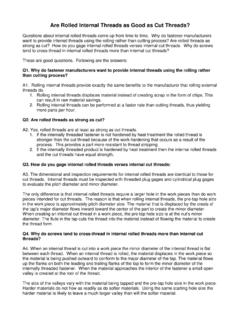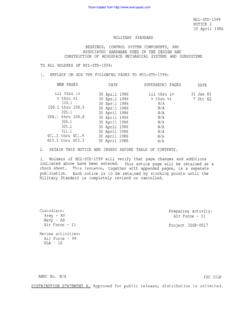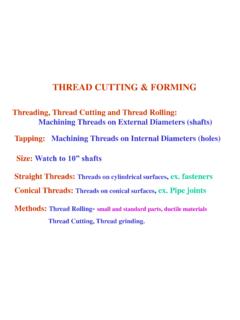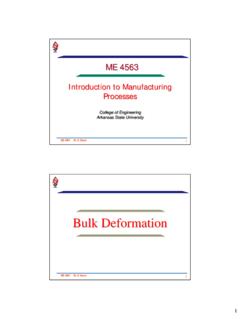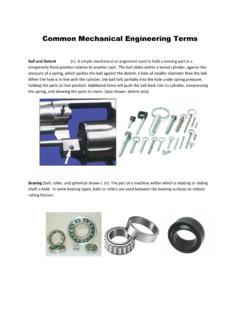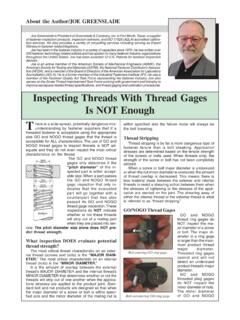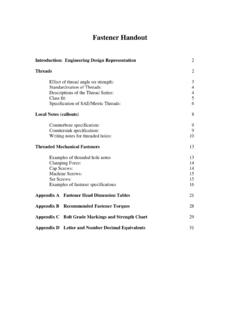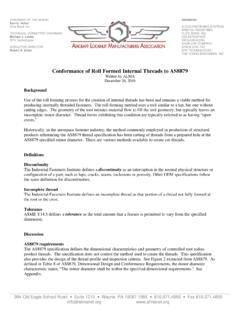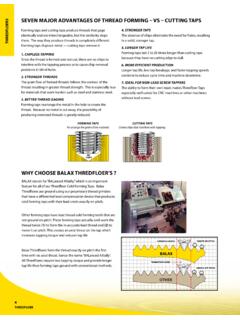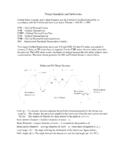Transcription of FASTENERS MASONRY FASTENER TECHNICAL DATA AND …
1 STRUT & HANGERSAUTO & ELECTRICALCHEMICALS& JANITORIALSAFETY PRODUCTSCONTRACTOR& INDUSTRIALTOOLS &ACCESSORIESDRILLS / SAWS& DATAAND CHARTSSECTIONIMPORTANT DISCLAIMERAll of the information provided in this sectionhas been assembled with concern for is intended for advisory purposes only anduse of this information is completely do not guarantee its completenessor validity and assume no responsibilityfor any loss, claims or damages resultingfrom use or application of this information is subjectto change without prior sure to verify!AUTO & ELECTRICALTOOLS & ACCESSORIESSTRUT & HANGERSDRILLS / SAWS& ABRASIVESSAFETY PRODUCTSFASTENERSCONTRACTOR& INDUSTRIALMASONRYANCHORSCHEMICALS& JANITORIAL149 FastenersPRODUCT CATALOG 2009/10 Industry standardsMost industrial FASTENERS are covered by two basic standards: one for materials and properties; the other, for dimensions and tolerances. Specifications for materials and properties are published by the American Society for Testing and Materials (ASTM), although other groups such as the Society of Automotive Engineers (SAE) also publish specifications covering these for dimensions and tolerances are issued by the American National Standards Institute (ANSI) in cooperation with the American Society of Mechanical Engineers (ASME) and the Industrial FASTENERS Institute (IFI).
2 Where applicable, published specifications covering a particular FASTENER will be referenced in the section of this booklet dealing with that referring to standards and specifications, we will use only the well-known initials of the above societies-ANSI, ASME, IFI, ASTM and FASTENERS are basic industrial FASTENERS - square and hex bolts, cap screws, carriage bolts, plow bolts, lag screws, studs, nuts, rivets and others - which have been standardized over the years as to type , style, usage, properties, dimensions and include a vast range of sizes and types stocked by distributors and manufacturers for an almost limitless range of applications: the assembly and maintenance of vehicles, appliances, farm equipment, construction equipment, industrial and plant machinery of all kinds, furniture and there s a need for holding parts together, holding them apart, holding them up, or holding them down, a standard FASTENER can usually be found to do the job efficiently and industrial FASTENERS are manufactured to a variety of standards covering dimensions, tolerances, materials, mechanical properties, testing procedures, FASTENER typesA Bolt is a device with a head on one end of a shank or body and a thread on the other end.
3 Designed for insertion through holes in assembly parts, it is mated with a tapped nut. Tension is nor-mally induced in the bolt to compress the assem-bly by rotating the nut. This may also be done by rotation of the bolt Screw is a headed and threaded bolt used with-out a nut. It is inserted into an internally tapped hole and tension is induced by rotation of the screw Stud is a FASTENER with no head but it has threads at both ends of the shank. It, like a screw, has one end that screws into a tapped hole. A nut is used on the other end to create a stud is threaded its entire shank length and a nut used on both ends to create tension, it serves the function of a bolt and is then classified as a Stud STANDARDS AND SPECIFICATIONSSTRUT & HANGERSAUTO & ELECTRICALCHEMICALS& JANITORIALSAFETY PRODUCTSCONTRACTOR& INDUSTRIALTOOLS &ACCESSORIESDRILLS / SAWS& FASTENER DATAterMInOLOGy and MeasureMentsThe diameter of all bolts is measured as the outside of major diameter of the thread .
4 The length of a headed bolt is measured from the largest diameter of the bearing surface of the head to the extreme end of the point in a line parallel to the axis of the bolt. For example, square or hex head bolts are measured from under the head to the end of the bolt; a bolt with a countersunk head is measured overall. The point of a bolt is always included in the measured FASTENERS such as studs are measured overall, including points, except for continuous- thread alloy studs made to ASTM Specification A193. This type is measured from first thread to first have various styles of heads. Some of the more popular styles are illustrated OF Head HEAVY HEADS AND NUTSBolt users may require a bolt head or nut of greater width to compensate for wide clearance in bolt holes or unusually heavy loading. For such needs we offer heavy bolt heads and nut sizes. Heavy nuts are quite common and readily available in various types and sizes but heavy head bolts have more limited AND NUT BEARING SURFACESCold-upset bolts made on a boltmaker usually are washer faced but large or very long bolts may have a flat face (not machined).
5 Nuts made on cold nut-formers may have double chamfered or washer faces. Large size nuts have hot-forged washer bearing faces, not machined, unless specially ordered. Round Round Countersunk (button) Square HexStandard hex bolt with hex nutAUTO & ELECTRICALTOOLS & ACCESSORIESSTRUT & HANGERSDRILLS / SAWS& ABRASIVESSAFETY PRODUCTSFASTENERSCONTRACTOR& INDUSTRIALMASONRYANCHORSCHEMICALS& JANITORIAL151 FastenersPRODUCT CATALOG 2009/10 Heat treatment covers various techniques that may be used to develop certain end-product characteristics. Customary procedures for FASTENERS include annealing,stress relieving, case hardening, direct quench and temper, and carbon thermal cycle involving heating to, and holding at a suitable temperature and then cooling at asuitable rate, for such purposes as reducing hardness, improving machinability, facilitating coldworking, producing a desired microstructure, or obtaining desired mechanical or other RELIEVINGA thermal cycle involving heating to a suitable temperature, usually 1000/1200 F, holding longenough to reduce residual stresses from either cold deformation or thermal treatment, and thencooling slowly enough to minimize the development of new residual HARDENINGA term descriptive of one or more processes of hardening steel in which the outer portion, or case, ismade substantially harder than the inner portion, or core.
6 Most of the processes involve eitherenriching the surface layer with carbon and/or nitrogen, usually followed by quenching andtempering, or the selective hardening of the surface layer by means of flame or induction AND TEMPERINGA thermal process used to increase the hardness and strength of steel. It consists of austenitizing, thencooling at a rate sufficient to achieve partial or complete transformation to should follow immediately, and involves reheating to a temperature below thetransformation range and then cooling at any rate desired. Tempering improves ductility andtoughness, but reduces the quenched hardness by an amount determined by the temperingtemperature industrial FASTENERS are manufactured from either carbon or alloy strength requirements are moderate, low-carbon steel is FASTENERS are made from medium-high carbonor alloy steels and are heat treated to develop desired FASTENERS are covered by specifications that define required mechanicalproperties such as tensile strength, yield strength, proof load, and STRENGTHThe maximum tensile stress in pounds per sq.
7 In. which a material is capable of sustaining, as developedby a tension STRENGTHThe stress at which a material exhibits a specified deviation from the proportionality of stress to deviation is expressed in terms of strain, and in the offset method, usually a strain of percent LOADThe point to which a material may be stressed without evidence of permanent resistance of a material to plastic deformation. Usually measured in steels by the Brinell, Rockwell,or Vi ckers indentation-hardness text TREATMENTMECHANICAL PROPERTIESSTRUT & HANGERSAUTO & ELECTRICALCHEMICALS& JANITORIALSAFETY PRODUCTSCONTRACTOR& INDUSTRIALTOOLS &ACCESSORIESDRILLS / SAWS& THREADSS crew threads are spiral grooves produced on the outside of a bolt ( external threads) or ma-chined inside a nut (internal threads). Four thread forms have been established by the ANSI: UN(internal and external threads). UNR ( external threads only), UNK ( external threads only), UNJ(internal and external threads).
8 The terms rolled thread and cut thread refer solely to the physical characteristics of commer-cial bolts or studs, not to the method of thread production. A cut- thread bolt has a shankdiameter equal to the threaded diameter; a rolled- thread bolt has a shank diameter less than thethreaded of thread fit are distinguished from each other by the amounts of tolerance 1A, 2A, and 3A apply to external threads; Classes 1B, 2B and 3B, to internal 1A and 1B are shown in ANSI standards but are rarely used. Most standard FASTENERS areproduced with a Class 2A fit for bolts and a Class 2B fit for nuts. The Class 2A allowance assureseasier assembly of mating parts, minimizes galling and seizing in high-cycle wrench assembly,and can be used to accommodate commercial electroplated finishes. Classes 3A and 3B affordno allowance or clearance for mating parts and are used chiefly for applications where a closetolerance fit is 5 is a special interference fit which results in an actual overlap of dimensions whenthreaded parts are fitted together.
9 It is normally used only on the tap-end of requirements are designated (1) by the number of threads per inch applied to aspecific diameter; (2) by the initial letters of the thread standard (UNR or UN); (3) by the lettersC, F, or numeral 8 to indicate coarse-, fine-, or 8- thread series; and (4) by the thread fit. Th efollowing example illustrates the method of designating a screw thread :1/2 in. -13 UNRC-2 Awhere1/2 in. = nominal diameter of thread13 = number of threads per inchUNR = thread form standard (Unified National Radius-Root)C = coarse- thread series2A = class of thread fitThe coarse- thread series (UNRC or UNC) is used on the vast majority of bolts and of threads per inch ranges from 20 threads for a 1 diameter bolt to 4 threads for bolt. Th e fine- thread series (UNRF or UNF) is found mostly in automotive andaeronautical work. Th reads per inch ra nge from 28 threads for a 1 bolt to 12threads for a 1-1 bolt. Th ere is no fine- thread standard for FASTENERS over 1-1/2 8- thread series (8 UNR or 8UN) is used only for sizes over 1 in.
10 In diameter, usually in high-temperature, high pressure OF thread FItcut Vs. rOLLed tHreadstHread FOrMsAUTO & ELECTRICALTOOLS & ACCESSORIESSTRUT & HANGERSDRILLS / SAWS& ABRASIVESSAFETY PRODUCTSFASTENERSCONTRACTOR& INDUSTRIALMASONRYANCHORSCHEMICALS& JANITORIAL153 FastenersPRODUCT CATALOG 2009/10 STANDARD STAINLESS STEEL SPECIFICATIONSType 301: Cr. 18, Ni. 8 (18-8 type), austenitic, hardenable by cold work only; , 80-270,000 psi: 30-240,000 psi.; elongation in 2 in., 40-5%. In rods, bars, billets, wire, sheet, plate, strip and tubing. For parts requiring good corrosion resistance combined with high tensile strength and good 302: Cr. 18, Ni. 8 (18-8 type), austenitic, hardenable by cold work only; 80-250,000 psi.; 30-225,000 psi.; elongation in 2 in., 60-5%; fair machinability excellent cold forming and welding properties. Furnished in sheet, strip, plate, bar, rod, forging billets and tube rounds, tubing, cold drawn shapes and structural shapes.


